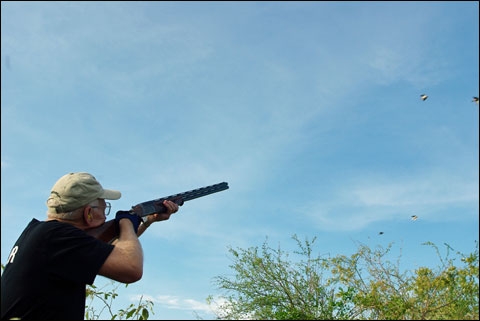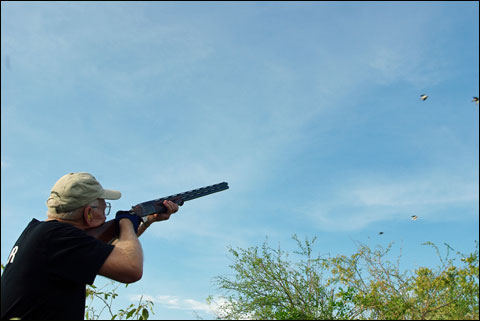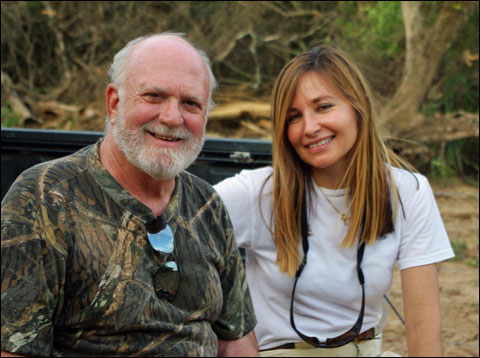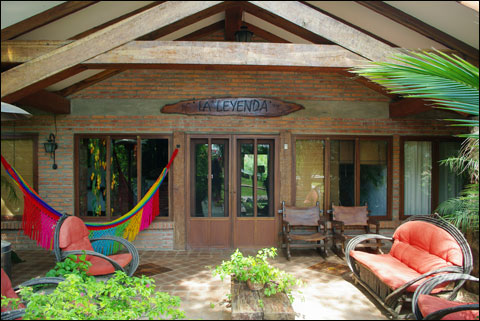Bolivia: South America’s Other Dove Shooting Paradise

While the Cordoba region of Argentina has long been recognized as the high-volume dove-shooting hotspot, Cordoba isn’t the only area of South America that is plagued with a massive dove population. In the late 1990s Uruguay became a much sought after dove-gunning goal for many. After the turn of this century Bolivia became yet another dove shooting paradise – though most of the USA’s shotgunners have not heard much about the Bolivian shooting yet.
I just returned from my third trip to Bolivia, and I’m here to tell you this country has a lot going for wing gunners. But first let’s get to the shooting. The first place outfitter Carlos Olano took Bob Schiermeier and I was very close to his lodge. The two of us, the only guests in camp, set up maybe 100 yards apart. Bob was dropped off first, and before I could get my gun uncased my partner was already starting to pepper the incomers.
It was plenty hot but my bird boy, Oscar, had me set up in the shade. Birds were coming into water – which was beyond where I was stationed. The time was mid-afternoon. Shot-wise Bob and I could take every angle possible as doves were coming in to our right and our left, as well as overhead, plus the doves that had their drink were coming out – offering all angling-away shots.
 This is just a small water tank (dug out of the flat land by a bulldozer), but many, many doves use such small watering spots.
This is just a small water tank (dug out of the flat land by a bulldozer), but many, many doves use such small watering spots.My favorite shot is the right to left crosser. This is when it is easy to keep the stock tight to my cheek – because I’m swinging the gun into my cheek. Further, as a right-hander I can swing a lot further to my left than I can to my right. Of course, this is true for all right-handed gunners.
Another shotgunning basic I was working hard on with my first two boxes of shells was a hard focus on the dove’s head, and if the bird was close enough – concentrating my stare on the dove’s eye. Toward the end of the second box I began connecting consistently, and more and more doves were stone dead in midair – having taken the full center of the shot pattern. The shells we were using were made in Spain – SAGA – and over the course of 4½ days of shooting I found them to be excellent.
After two boxes were spent – and re-learning how to hit those right to left crossers – it was time for a change. As Oscar poured the third box into my shell bag huge waves of doves passed overhead – hundreds and hundreds. But now it was time to work on the left to right crossers – always a challenge for me. I can’t swing as far to the right as I can to the left – plus as those gun swings can result in a tendency to move the gun away from the cheek – not a good or a productive idea. Within a couple of shots I decided to work on yet another aspect of shotgunning fundamentals – I worked on my turn – like from the ankles up. My tendency over the years is to not concentrate on the turn enough so I end up being too much of an arm swinger – again – not a good or productive idea.
After two more boxes were fired at only left to right crossers it was time for a change again. While I thought briefly about what shot to concentrate on next hundreds of birds flew within gun range – unscathed as I never touched the safety. By the time Oscar had poured box number five into my shell bag I decided I’d go with quartering shots – doves leaving the water hole. To me it’s always amazing how little lead a quartering away bird requires – compared to a hard 90 degree crosser. Where possible on a quartering away shot it helps to have the muzzles already pointed in the direction of where you think the bird is going to be. Doing so cuts down on muzzle movement – always a good thing when working on your shooting basics.
After a couple of boxes shooting at those quartering away birds I figured I had my basics down pat. Now if I could only remember what I’d learned and tried on the first six boxes of shells. So it was time to just pick a bird, turn, hard focus, stay in the gun and shoot. Right to left shots, left to right shots, quartering away shots – now it didn’t matter – I took any dove.
One of the important aspects of a high-volume dove shoot is that most of us do not kill a high percentage of birds with that first box of shells. When I hunt doves here in the USA it’s usually tough for me to kill 10 doves with 25 shells. But in South America I can get locked in quickly – if you call shooting those first 150 shells getting locked in quickly. By the second day I’m killing 18-22 birds with 25 shells. By the third and fourth days I’m very occasionally killing 25 doves with 25 shells. Yes, in Bolivia it’s easy to get tuned in with your shooting.
 The flights of doves are endless – no matter whether you are shooting birds going to food, water or their roost.
The flights of doves are endless – no matter whether you are shooting birds going to food, water or their roost.I took two guns on this trip: a 12 gauge Perazzi MX8 with 28 ½-inch barrels and a 20 gauge Caesar Guerini Summit Sporting with 32-inch barrels. I ended up shooting the 20 gauge slightly better than the 12. The SAGA shells I shot – in 12 gauge 24 gram (7/8 ounce) International Trap loads at 1325 feet per second, the 20 gauge shells 28 gram (1 ounce) at Max Dram velocity. Shell prices in South America have always been high, but they seem to be growing higher. I paid $13.50 a box, so shell cost is a major factor in the overall high-volume dove shooting experience. I paid more for the shells than I did for my airfare!
Carlos Olano learned his ABCs in outfitting for doves from his father. The dad was a pioneer in opening up Colombia’s Cauca Valley to high-volume dove gunning – starting in the late 1960s. As a youth Carlos started working with his father in the outfitting business – taking over the Cauca dove operation in 1985. Pablo Escobar and other drug lords eventually became kings in the Cauca Valley, and dove-shooting operations ceased.
Olano and his wife Olga soon ended up in Bolivia – managing dove operations in another lodge. Four years ago Carlos and Olga built their own lodge – La Leyenda – and that’s where I shot on my third trip to Bolivia. The lodge is deluxe in every respect – with every amenity you have come to expect at top shooting lodges everywhere. The food was excellent, and there was an open bar, swimming pool, daily laundry as well as brand new vehicles to get the hunters from the lodge to the field.
 My shooting compatriot Bob Schiermeier and Olga Olano.
My shooting compatriot Bob Schiermeier and Olga Olano.Let’s get back to the shooting. The in thing among serious wing gunners these days is high birds. No matter where you shoot doves in South America there are always plenty of high birds, and Bolivia is no exception. You can shoot box after box at 60 yard and farther birds – all day long. I have done this in South America from time to time, and it’s a hoot – choking up with Full screw-ins and giving those bus-like leads. On the various types of driven bird shoots in Great Britain and Europe the terrain often dictates how high the pheasants or partridges will be, but in South America it’s almost impossible to look up at any time and not see a very far shot opportunity.
A typical day at La Leyenda is an early wake up call and just some fruit for breakfast. Then it’s off for a very short ride – to shoot doves coming from roost to feed. This shooting will last for about three hours, and then it’s back to the lodge for your rightful eggs, bacon, juice, toast and more. Rest a couple of hours, and then leave about two in the afternoon. This involves a drive to some watering hole (described in my opening – which was our first shoot upon arrival). Shoot doves coming in and out of water until that wanes. Next comes about 90 minutes or more of extremely hot-barreled action as Carlos sets you up on the edge of a huge dove roost.
But at least one day during your stay you will be gone from the lodge all day, lunching in the field. On that day you will shoot a variety of (1) birds flying to feed, (2) birds flying back from feed, (3) doves going and coming from water and (4) definitely shooting at the edge of a big roost to wrap your high-volume day up.
 Carlos Olano continues to try and pinpoint dove flight paths using his binoculars.
Carlos Olano continues to try and pinpoint dove flight paths using his binoculars.The overnight flights to Bolivia are shorter than the flights to Cordoba. Further, the flights home from Bolivia are during the day – not overnight – the flight leaving in the morning – getting you to Miami in time for a connection to get you home that same day. American Airlines has overnight flights to La Paz (the capitol) from Miami. Stay on the plane – then it’s an hour’s flight to Santa Cruz – your drop off point to the dove shooting – where you are met by Carlos. Only a few years ago it was necessary to fly by small plane charter into La Leyenda Lodge (as well as the other dove lodges in this country) because it was a dirt road most of the way – along with a one-way bridge that caused regular delays of hours, sometimes days. But now there’s a new high-speed highway to within a few miles of the lodge – that trip taking only about an hour. One bonus of this new arrangement is that you shoot all day the last day. Carlos drives you into Santa Cruz early the next morning for your nine o’clock departure to Miami. I really like the idea of a full day’s shooting that last day.
 La Leyenda Lodge.
La Leyenda Lodge.Did I mention the wind? It was windy all four and a half days of my stay, and it got windier every day – with gusts to 50 miles an hour the last day. Because it was so hot the high winds made the heat more comfortable, but those winds had the birds offering big, big shotgunning challenges for Bob and me.
The shooting in Bolivia is not year-round like it can be in Argentina and Uruguay. The doves start arriving in this huge agricultural area mid to late April. They leave in late October or early November. This agricultural area is called the Grand Chaco. It extends north of where we shot about 100 miles, but the Grand Chaco extends southward all the way through Paraguay and even into the northern most part of Argentina. The Mennonites are largely responsible for opening up this area to farming – which they started doing only a few decades ago. The main crops are sunflowers, sorghum, wheat and corn – all loved by the doves.
One agent who can book you to La Leyenda Lodge is Trek Safaris – on the web www.treksafaris.com – via phone 800-654-9915. To contact Carlos Olano directly it’s olanolano@hotmail.com.
Nick Sisley welcomes your emails at nicksisley@hotmail.com. A full time freelance writer since 1969, Nick has traveled the world in search of story material – and especially the best wingshooting destinations. His thousands of articles have appeared in many, many magazines, and he’s the author of eight books, is an NSCA, NSSA and NRA Shotgun Instructor.

Nick Sisley welcomes your emails at nicksisley@hotmail.com. Sisley has been writing full time for 43 years, his thousands of articles appearing in many, many magazines. He’s the author of eight books, is an NSCA, NSSA and NRA Shotgun Instructor and a pilot with many ratings.


Comments